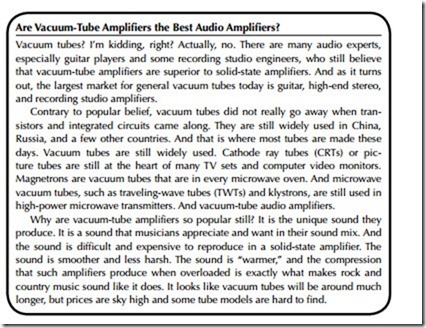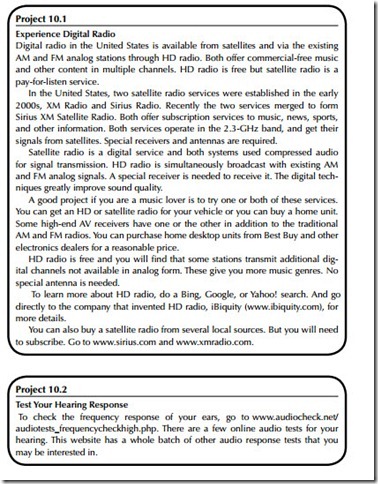SPECIAL SOUND APPLICATIONS
When you think of audio or sound, you think mainly of voice or music reproduction. Yet, electronic sound is used in lots of additional places. Some interesting examples are in musical instruments, sonar, ultrasound, and hearing aids.
Musical Instruments
Musical instruments produce their own sounds, of course. Each has its own unique signature made up of the basic notes or tones to which are added the mix of harmonics or overtones unique to the physical structure of the instrument. Some instruments like horns and drums rarely need amplification. Other instruments like guitars and violins commonly need some amplification, especially in large venues such as on stage addressing hundreds or thousands of people. Special microphone-like devices called pickups are used with string instruments. The pickup is usually one that converts the string vibrations into a small signal that is then amplified.
One of the most popular electronic instruments is the synthesizer. It has a keyboard like a piano. The keys are equivalent to those on a piano. Each key then triggers the electronics to generate a tone of the desired frequency. That tone is especially modified by DSP circuits to sound like that note played on a piano, an organ, or any other musical instrument. The DSP synthesizes or constructs the tones digitally and sends them to a DAC that converts them into the analog sound to be amplified.
Noise-Canceling Earphones
You have probably heard of these or maybe seen or used them. They make clever use of analog signal processing to greatly minimize surrounding noise when you are trying to listen to music with headphones.
First, most of these headphones try to isolate the actual headphone from the surroundings with a tight-fitting ear bud or soft foam pads around the earphone that limit the amount of external noise getting to your eardrum. This is called passive noise control.
Second, each earphone contains a built-in microphone that picks up the surrounding noise. It amplifies it then inverts it in phase. The original noise from the microphone is then added to the inverted noise. Being the same but exactly out of phase with one another, the two noise signals cancel one another. The cancellation is not perfect, but the noise reduction is significant. It can greatly minimize noise on a plane or in a car or other types of noisy environments.
Sonar
Sonar means sound navigation and ranging. It is basically the underwater equivalent of radar. It is used on ships and submarines for making depth measurements, detecting underwater objects, and for warfare. The two types of sonar are passive and active.
Passive sonar is simply the idea of putting underwater microphones called hydrophones on a long wire or arrays of such microphones in the water to listen for any sounds that occur. Amplifiers boost the signal levels and various filters help sift through all the complex signals that can be heard. In military applications, the sounds are digitized and various DSP programs help filter and identify specific sounds. Many ships create unique sounds called signatures that can be digitized and stored for comparison to any sounds picked up for positive identification. The sounds include fish and other sea life, boat and ship engines, motion through the water by a ship or boat, or any noise that occurs inside a submarine. Sound travels very easily through water so is easy to pick up. With practice and experience, a sonar operator can identify almost everything occurring over a wide range around the microphone array.
The other form of sonar is active. This is like radar where a high-frequency pulse of sound is applied to a transducer to convert the pulse into sound waves for transmission through the water. The frequency of the pulse is usually ultra- sonic, that is, above most human hearing. Frequencies from about 15 kHz to 1 MHz are used, depending on the application. The pulse of sound travels out from the transducer and is then reflected off distant objects. The reflections go back to the source where they are picked up by a microphone. Then, knowing the speed of sound transmission in water, the distance to the object can be computed. Sonar depth sounders point the transducer downward to get a mea- sure of the distance to the bottom. Sonars can easily pick up reflections from ships miles away for navigation safety purposes or for military actions.
Hearing Aids
Electronic hearing aids have been around a long time. The older analog types were large and cumbersome but worked fine. Integrated circuits made them much smaller and more acceptable to the hearing impaired. Today, the newer hearing aids use digital technology. The microphone picks up the sound and amplifies it then digitizes the sound in an ADC. A DAC can then translate the
sound back into audio for amplification and application to the earphone. Most digital hearing aids now incorporate DSP filters. These filters may be customized to the frequency response of the ear, correcting for different frequencies. Mostly the high-frequency response is lost due to aging. Using an external computer, each hearing aid can be adjusted from volume and frequency response to fit the exact deficiency.

